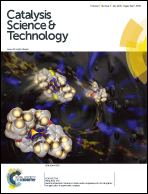Correlation between the structural characteristics, oxygen storage capacities and catalytic activities of dual-phase Zn-modified ceria nanocrystals†
Abstract
Doping ceria with heterocations is a commonly applied strategy to alter its structural and chemical properties including its key feature oxygen storage capacity (OSC). Although a few papers have been published on the structural properties and chemical reactivity of Zn-doped ceria, one lacks a comprehensive investigation on the effect of zinc incorporation in the ceria lattice on its structural properties, and how it could be correlated to the changes in its chemical reactivity including OSC and catalytic activities. Here, we have established an interesting correlation between the structural properties of dual-phase Zn-modified ceria nanocrystals, their OSCs, and their catalytic performance for the reverse water-gas shift (RWGS) reaction and soot oxidation. Upon incorporation of zinc in the ceria lattice, the degree of crystallinity is decreased according to XRD. Raman spectroscopy reveals a concomitant increase of oxygen vacancy concentrations within the Zn-modified ceria samples in comparison to pure ceria. The incorporation of zinc increases the reducibility of ceria according to H2-TPR and doubles the OSC as revealed by thermogravimetric studies. When the variations of the degree of crystallinity, the oxygen vacancy concentrations and the OSCs within the Zn-modified ceria samples are compared, an excellent correlation is established. Catalytic testing shows that Zn-modified ceria exhibits higher activities for the RWGS reaction, especially at the lower temperatures of 400 °C and 600 °C, while at 800 °C the catalyst deactivates rapidly. Such deactivation at high temperature can be totally eliminated by impregnating additional cobalt oxide on the ceria support. Some improvement in the soot oxidation activity is achieved with Zn-modified ceria, attributed to enhanced OSCs of the materials. Within the set of Zn-modified ceria samples, the activities are essentially identical, which is again correlated to their nearly identical OSCs, irrespective of the zinc concentration. Upon impregnation of additional cobalt oxide, the materials' activities for soot oxidation are markedly enhanced, as observed with the RWGS reaction. Pure ceria and Zn-modified ceria samples perform significantly better for soot oxidation after being leached with citric acid. Such enhancement is more pronounced with CZ10 (10 mol% zinc) in comparison to pure ceria. This observation suggests that the removal of non-incorporated ZnO increases the activity for soot oxidation.


 Please wait while we load your content...
Please wait while we load your content...